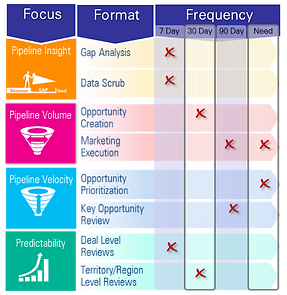Lead with a Strong Sales Management Cadence
Sales transformation efforts are only successful when the people closest to customers change behaviors. No doubt the change has to start with executive leadership. But transformation will only take hold when first-line managers reinforce the desired changes.
To execute consistently managers must have a structured set of review and coaching practices that take place in a predictable sequence. This concept is often referred to as the sales management “cadence” or “rhythm”.
Four Critical Sales Management Disciplines
The life of a sales manager is busy and complicated. So it might seem unfair to reduce the job down to just four things. And it is. But, in fact, there are four management disciplines that matter more than anything else. Here is a brief look at each one.
-
Pipeline Insight. The ability to view accurate sales pipeline data to develop insights that lead to effective activity. Important factors here include: size and timing of actual-to-quota gap, value of active opportunities, and status of top deals.
-
Pipeline Volume. The ability to identify net new sales opportunities through customer insight and marketing efforts.
-
Pipeline Velocity. The ability to manage sales opportunities through the customer’s buying process efficiently by focusing on the value.
-
Predictability. This discipline involves the ability to predict performance against objectives-- forecasting in other words. And while success here requires some specialized processes, it also depends upon execution in the preceding three disciplines.
Having these disciplines in place as part of your sales management routine serves to create relevant context for effective coaching. And it keeps the team focused on predictable revenue generation.
Designing Your Cadence
The System Selling approach to designing the sales management cadence is to start with the core discipline areas as organizing themes. From there we determine the specific format for coaching sessions managers will use to drive specific selling behaviors and help sellers with personal development.
Frequency of these coaching sessions is the final critical design decision. Balance is the key here. If we set the cadence with too many sessions too often we rob sellers of the time they need for working with customers. Too little intervention and sellers will revert to ad hoc processes, or perhaps even begin to feel unsupported.
Example Sales Management Cadence


